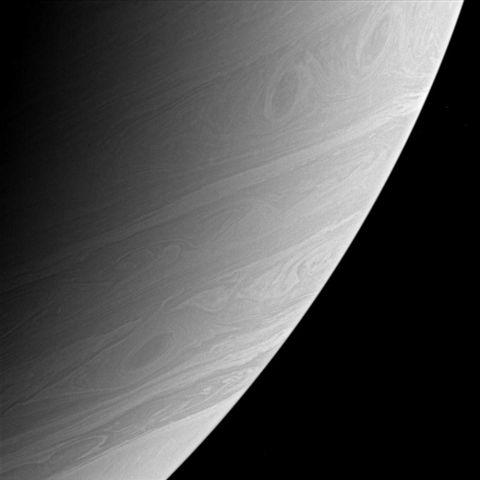A brief overview of all active American spacecraft in the solar system and other main NASA missions
Michal Levinstein, Israel Astronomical Society

Storms on Saturn: Photo - Cassini spacecraft
On 14/1/04, US President George Bush presented a task to NASA - to land people on the moon before the end of the next decade, in order to pave the way for manned journeys to Mars and beyond.
Two years later, NASA is about to make the vision a reality. It revealed the plans for a new generation of spacecraft - (CEV) Crew Exploration Vehicle - based on the best technology of "Apollo" and the space shuttles. Humans and robots will collaborate on future exploration missions.
On Mars - the Spirit and Opportunity probes are starting their third year, in what was initially defined as a 90-day mission to the Red Planet. A new mission - Mars Reconnaissance Orbiter - arrived on Mars in March. The Cassini-Huygens mission is bringing back breathtaking images of Saturn and its moons. The Hubble, Spitzer and Chandra space telescopes shed new light on the mysteries of deep space, far from our solar system.
On 4/7/05 the Deep Impact probe collided with comet Temple 1 and recorded the collision and its results. On 15/1/06 the Stardust returned comet particles to Earth.
On 19/1/06, NASA launched the New Horizons mission to explore the most distant planet in the solar system - Pluto.
New Horizons
On 19/1/06, the New Horizons spacecraft was launched into space from Cape Canaveral in Florida on a Lockheed-Martin Atlas V rocket. Its mission is to reach the farthest edge of our solar system. The spacecraft is designed to meet Pluto in 2015. As the first spacecraft to visit Pluto and its moon Charon - it will try to decipher one of the last and greatest secrets of our solar system. The 7 instruments that will be on the probe will measure the properties of the surface, geology and atmosphere. After the encounter, the spacecraft will continue far towards the Kuiper belt and will explore it for 5 years (until 2020).
More information about the mission can be found on the NASA website
Stardust
On 17/1/06, the (JSC) Johnson Space Center began investigating what the Stardust spacecraft brought back from its mission. The chief researcher of the mission - Dr. Donald Brownlee Dr. Donald Brownlee - says that the mission succeeded beyond the greatest expectations that were placed on it. The researchers have so far removed many fragments of Aerogel and discovered many particles inside them. They also found many small craters in 7 aluminum sheets. 7 teams work simultaneously on the samples.
More information about the mission can be found on the NASA website
Mars Reconnaissance Orbiter MRO
On 12/8/05, the MRO orbiter was launched towards Mars (suggested translation: "a spacecraft from Mars was launched towards Mars") MRO. So far he has completed (?) 60% of the distance and reached his destination on 10/3/06. After 40 million km it will begin to circle Mars. After six months of orbit adjustments, it will begin scientific experiments. It is designed to return more information than all previous tasks combined. The mission will examine Mars from low orbit - water (liquid, ice and vapor), geology and minerals. Also, possible landing sites on Mars will be examined.
More information about the mission can be found on the NASA website at
ISS International Space Station
The International Space Station is manned by the 13th crew which includes Pavel Vinogradov and Jeffrey Williams. When the shuttle Discovery arrives at the station, the German astronaut Thomas Ritter will also be added to them.
More information about the ISS can be found on the NASA website
Hubble space telescope
The Hubble Space Telescope is celebrating its 15th year in space. Among his latest discoveries - new rings and moons around the planet Uranus, 2 new optional moons for Pluto, new details about
Our moon and more.
More information about the Hubble telescope can be found on the NASA website
Spitzer Space Telescope
Among the recent discoveries of the "Spitzer" space telescope - optional remnants of cometary dust around the star G29-38 that died 500 million years ago, stars dying and being born in the region at the center of our galaxy, energy flares associated with star clusters and more.
More information about the Spitzer telescope can be found on the NASA website
Chandra x-ray observatory
Among the latest discoveries of the Chandra X-ray telescope - the special structure of the Cartwheel Galaxy is probably the result of a collision with a small galaxy a few hundred million years ago, black holes that trigger massive activities in elliptical galaxies and more.
More information about the Chandra Telescope
business center
The solar observatory satellite SOHO (Solar and Heliospheric Observatory) of the American space agency NASA - celebrated on 2/12/05 10 years of its activity. The mission is shared by NASA and the European Space Agency. Its purpose is to study the activity of the sun, in order to understand more about solar storms that can damage communication satellites and power plants. In the last decade, the mission contributed to the understanding of the structure of the Sun, its atmosphere and the solar wind.
More information about SOHO can be found on the NASA website
Cassini
The Cassiny mission ends a fruitful year of research of Saturn's moons - Enceladus, Dione, Rhea, Hyperion, Lapetus. On 27/1/06, Saturn was in opposition - at its shortest distance to Earth.
More information about Cassini can be found on the NASA website
Spirit & Opportunity
On 3/1/06 the Spirit probe celebrated the beginning of its third year on Mars, and on 24/1/06 the Opportunity rover celebrated its second year. The two probes are cooperating in the study of the primordial conditions that prevailed on the surface of the Red Planet.
More information about the exploration of Mars can be found on the NASA website
https://www.hayadan.org.il/BuildaGate4/general2/data_card.php?Cat=~~~504478211~~~8&SiteName=hayadan
